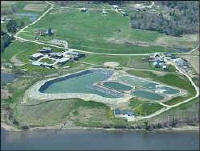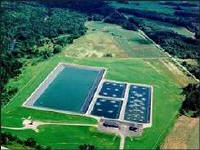
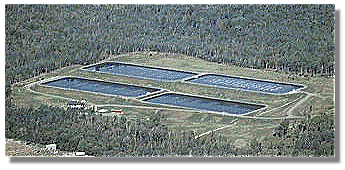
The goal of improving the
water quality of the Piscataquis River is closer to reality
with the completion of the pollution control facilities designed by
Wright-Pierce for the Towns of Guilford and Sangerville. The
Guilford-Sangerville Sanitary District is responsible for the
treatment of wastewater from these two towns and from Guilford
Industries, a major textile manufacturer. Planning for the project
dates back to 1976 when facilities studies were first begun. Prior to
the construction of the new sewer system and treatment facility,
untreated municipal and industrial wastewater from the villages of
Guilford and Sangerville was discharged into the Piscataquis River
creating public health concerns. Of particular concern was the adverse
effect that these raw sewage discharges were having on the river's
fish population and on downstream drinking water supplies. After
careful evaluation of the treatment options, Wright-Pierce recommended
the construction of a new sewer system and aerated lagoon treatment
process, with possible future post treatment to handle residual
pollutants. This system provides the most cost effective means of
achieving the required high level of treatment needed to protect the
river and downstream water supplies. The completed facilities include
40,000 feet of gravity sewer, 5 pump stations, 16,000 feet of force
main and a 4 cell aerated lagoon facility.
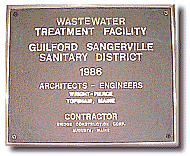
The largest of the pump stations
includes comminution and chemical addition facilities designed for a
peak pump capacity of 3,000 gallons per minute. The lagoons, lined
with high density polyethylene to protect the groundwater, have a
total volume of 38 million gallons. Disinfection of the treated
effluent is achieved by chlorination followed by dechlorination to
reduce the detrimental effects of chlorine on the Piscataquis River.
Due to
the large volume of high strength industrial waste discharged by
Guilford Industries, the treatment system required the flexibility to
modify its operations in response to changes in industrial waste
volume, strength and characteristics. System flexibility is achieved
by using variable effluent recycle, bypass/step feed capabilities and
a fine bubble aeration system designed to allow positive, adjustable
distribution of air.
Recycling of
the effluent enables the operator to dilute the high strength incoming
waste with treated effluent. It also allows seeding of the incoming
wastewater with bacteria acclimated to the waste.
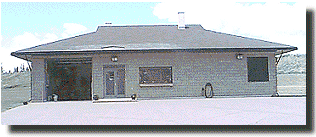
The facility's
wastewater piping configuration allows for splitting of the influent
flow to more than one lagoon. Any lagoon can be bypassed for
maintenance reasons and its contents pumped to the other lagoon by the
effluent recycle system.
To provide the
needed air for the treatment lagoons, Wright-Pierce incorporated a new
11 state-of-the-art" aeration system. The aeration system consists of
fine bubble porous plate diffusers resting on the bottom of the
lagoons. This system was selected for its comparative high efficiency
and low maintenance coupled with its flexibility and reliability.
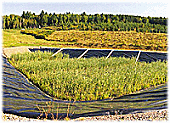
Reedbeds have been constructed and are currently being used
for sludge treatment.
The total
construction cost of the wastewater collection and treatment
facilities was approximately $8.8 million. State and federal grants
paid for 80% of the cost. The Farmers Home Administration provided
long-term financing of the District's share of project costs.
Basic Design Data
| Design
BOD Load: |
3,600
lb/day |
| Design
COD Load: |
15,000
lb/day |
|
Total Lagoon Volume: |
38.0
MG |
|
Design Detention Time: |
38
days |
Lagoon Specifications
|
Lagoons |
No.1 |
No.2 |
No. 3 |
No. 4 |
|
Volume |
9.5 MG |
9.5 MG |
9.5 MG |
9.5 MG |
|
Lagoon Dimensions |
475' x 250' x 18' |
475' x 250' x 18' |
475' x 250' x 18' |
475' x 250' x 18' |
|
Lagoon Acreage |
2.72 acres |
2.72 acres |
2.72 acres |
2.72 acres |
|
Aeration |
Fine Bubble |
Fine Bubble |
Fine Bubble |
Fine Bubble |
|
No. of Aerators in Each Lagoon |
150 |
75 |
48 |
27 |
Comments:
Total lagoon acreage is 10.9 acres or
474,999 square feet. Facility has (4) 125 horsepower blowers. Aeration
system manufacturer is Environmental Dynamics, Inc. and diffuser model
is the Reef I. There are 300 total aerators in the lagoons. Facility
first began removing sludge in 1999.
System Information
|
Design Flow |
1.0 MGD Peak Flow 2.21 |
|
Actual Flow |
0.40 MGD |
|
Discharge To |
Piscataquis River |
|
Year Built |
1988 |
|
Design Engineers |
Wright-Pierce |
|
Septage Received |
No |
|
Collector System |
11 miles
of gravity, 300+ manholes, 7 pump stations |
|
Staff Size |
Two Full
Time |
|
Number of Users |
550
Services |
|
Billing Software |
Business Management Systems |
|
Comments |
70% of
flow comes from textile plant. Sludge is deposited in reedbed for
treatment. Reedbed is 3,000 square feet in area. Bed is triangular
shaped, 5 feet in depth. |
Process Schematic
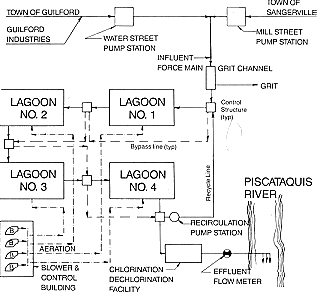
CONTRACTOR
Bridge Construction Corp.
Augusta, Maine

|
Operator Name |
Frank
Ruksznis |
|
Facility Address |
Dover
Road |
| |
Guilford, Maine 04426 |
|
Telephone |
(207)
876 - 4598 |
|
Fax |
(207)
876 - 4598 |
Back to Lagoons in
Maine

